EGN-3333: Measurement & Identification of Occupational Illnesses
VerifiedAdded on 2023/06/11
|8
|978
|61
Report
AI Summary
This report focuses on the identification and measurement of occupational illnesses within the context of health, safety, and environment, specifically addressing the EGN-3333 course requirements. It highlights the importance of integrating occupational health and safety practices into organizational structures to mitigate workforce health injuries and illnesses. The report uses online journals and articles to analyze factors contributing to occupational health and safety violations, reviewing local and international regulations. Key aspects covered include occupational diseases caused by chemical, physical, and biological agents, and the criteria for identifying occupational diseases, such as strength of association, consistency, specificity, and biological plausibility. The project concludes by emphasizing the necessity of addressing occupational health and safety to ensure workforce well-being, referencing various studies and regulatory frameworks. Desklib provides access to similar reports and solved assignments for students.
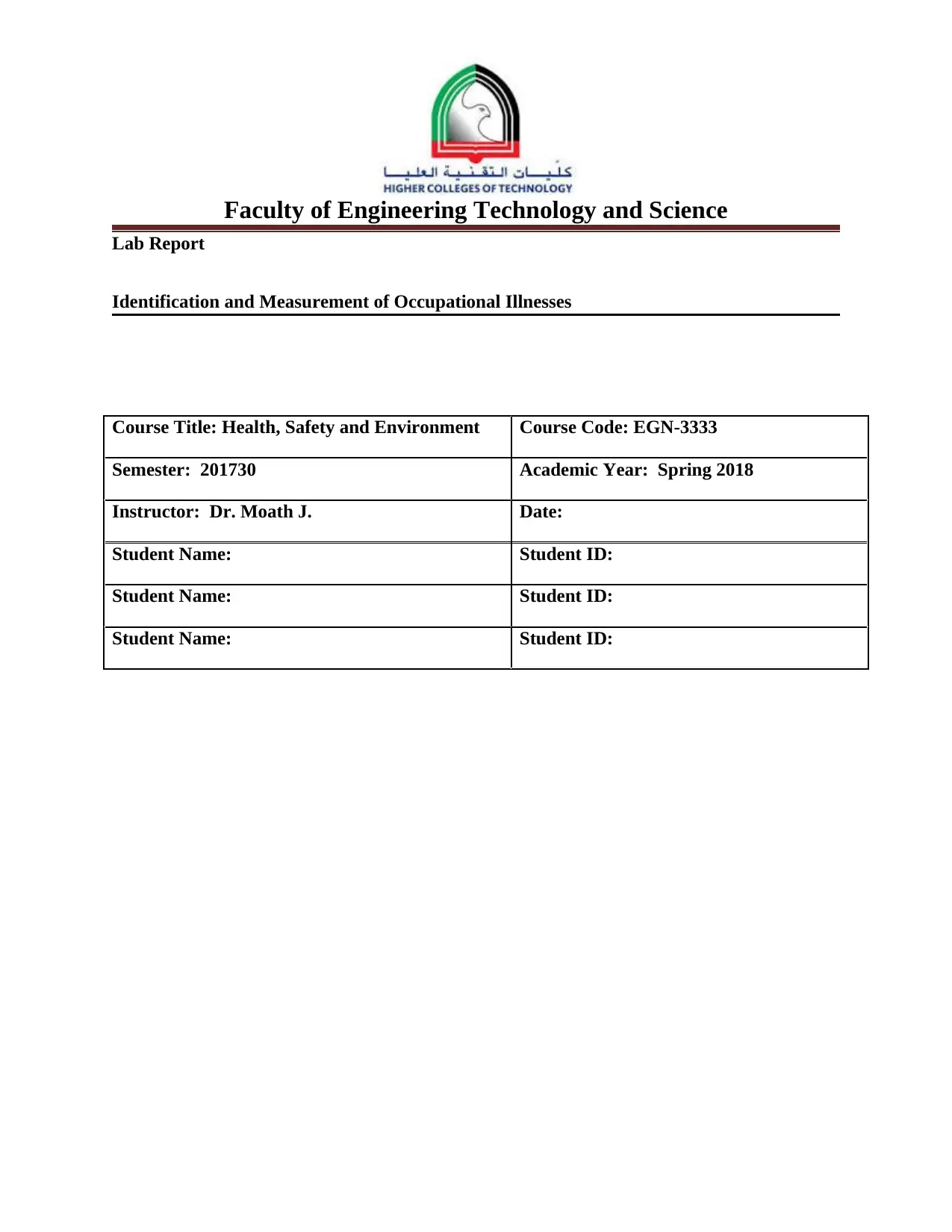
Faculty of Engineering Technology and Science
Lab Report
Identification and Measurement of Occupational Illnesses
Course Title: Health, Safety and Environment Course Code: EGN-3333
Semester: 201730 Academic Year: Spring 2018
Instructor: Dr. Moath J. Date:
Student Name: Student ID:
Student Name: Student ID:
Student Name: Student ID:
Lab Report
Identification and Measurement of Occupational Illnesses
Course Title: Health, Safety and Environment Course Code: EGN-3333
Semester: 201730 Academic Year: Spring 2018
Instructor: Dr. Moath J. Date:
Student Name: Student ID:
Student Name: Student ID:
Student Name: Student ID:
Paraphrase This Document
Need a fresh take? Get an instant paraphrase of this document with our AI Paraphraser
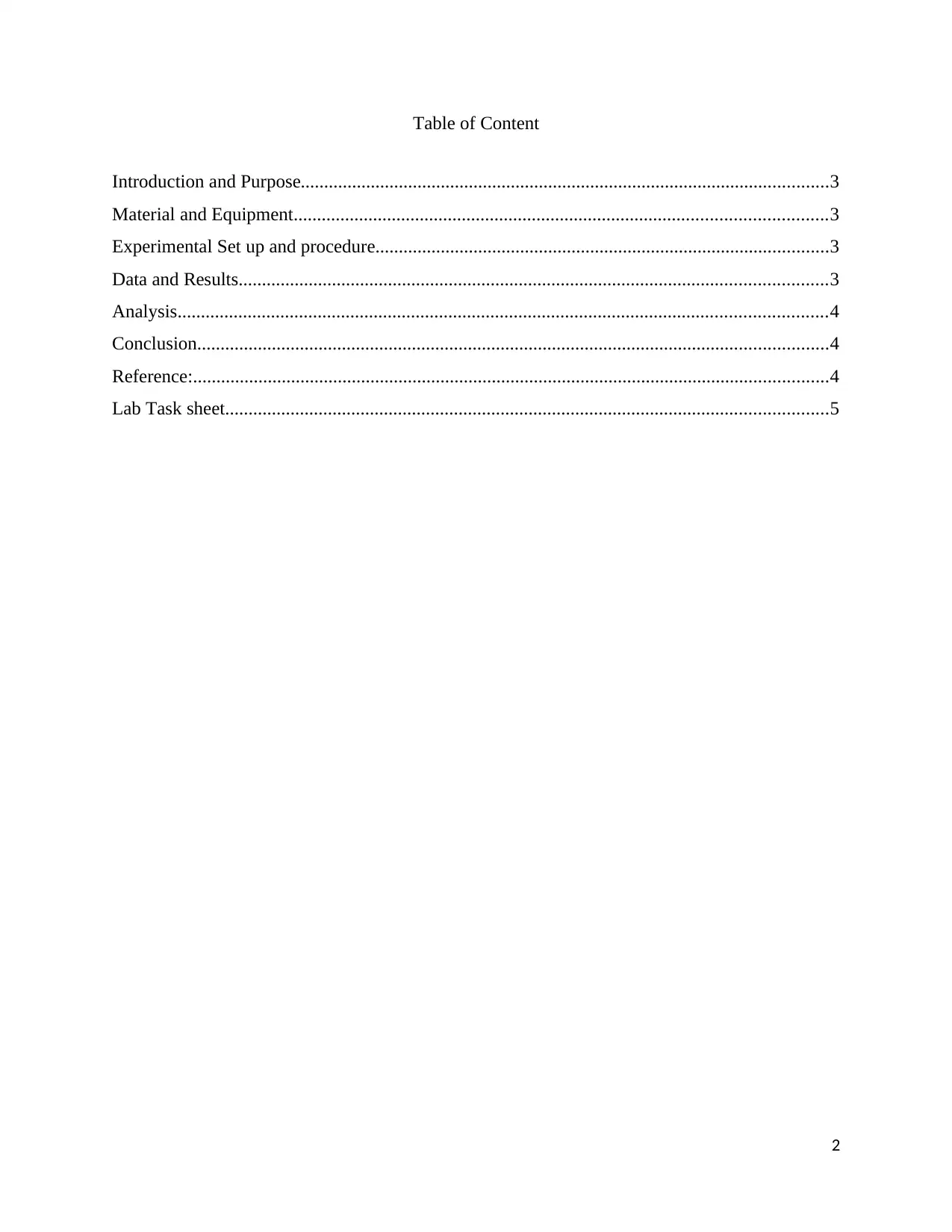
Table of Content
Introduction and Purpose.................................................................................................................3
Material and Equipment..................................................................................................................3
Experimental Set up and procedure.................................................................................................3
Data and Results..............................................................................................................................3
Analysis...........................................................................................................................................4
Conclusion.......................................................................................................................................4
Reference:........................................................................................................................................4
Lab Task sheet.................................................................................................................................5
2
Introduction and Purpose.................................................................................................................3
Material and Equipment..................................................................................................................3
Experimental Set up and procedure.................................................................................................3
Data and Results..............................................................................................................................3
Analysis...........................................................................................................................................4
Conclusion.......................................................................................................................................4
Reference:........................................................................................................................................4
Lab Task sheet.................................................................................................................................5
2
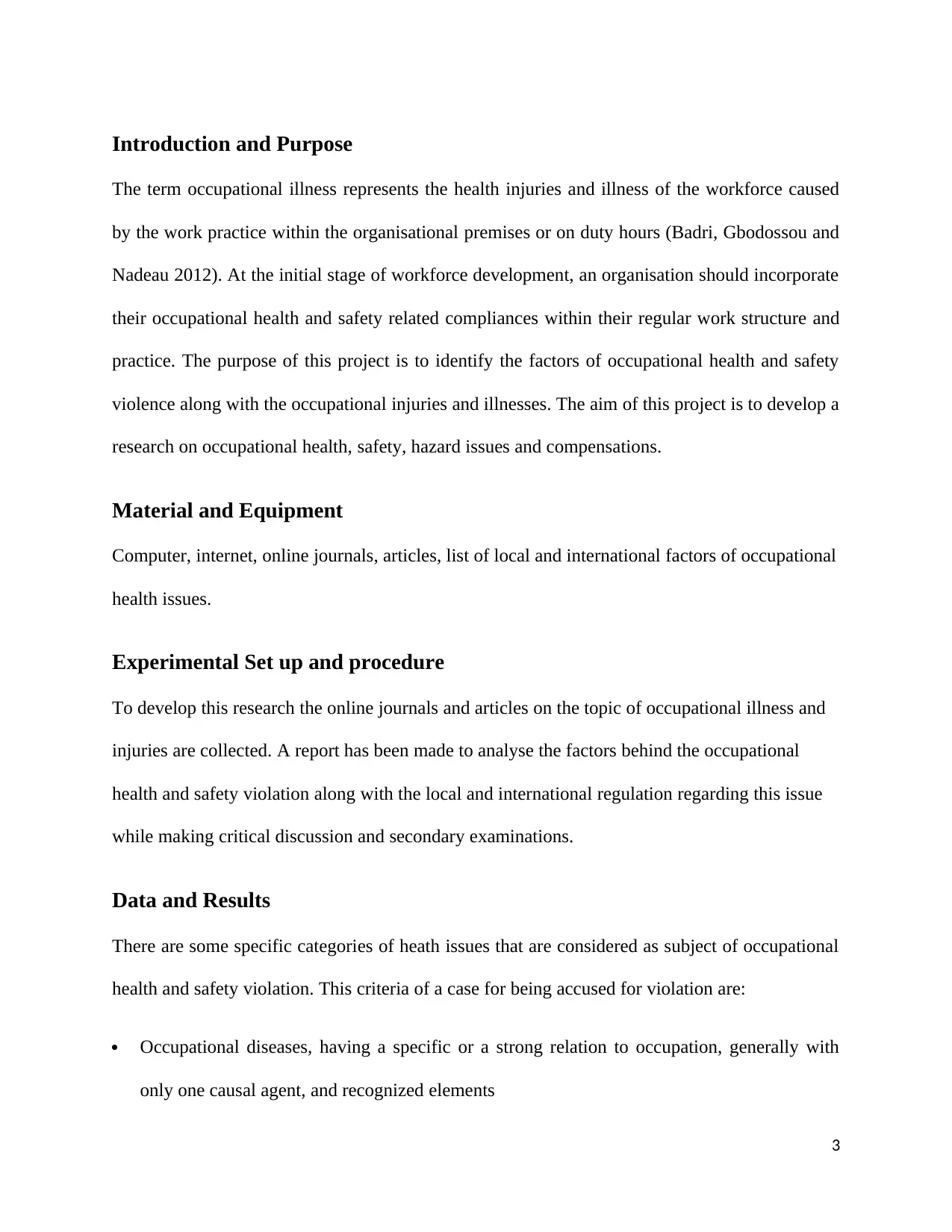
Introduction and Purpose
The term occupational illness represents the health injuries and illness of the workforce caused
by the work practice within the organisational premises or on duty hours (Badri, Gbodossou and
Nadeau 2012). At the initial stage of workforce development, an organisation should incorporate
their occupational health and safety related compliances within their regular work structure and
practice. The purpose of this project is to identify the factors of occupational health and safety
violence along with the occupational injuries and illnesses. The aim of this project is to develop a
research on occupational health, safety, hazard issues and compensations.
Material and Equipment
Computer, internet, online journals, articles, list of local and international factors of occupational
health issues.
Experimental Set up and procedure
To develop this research the online journals and articles on the topic of occupational illness and
injuries are collected. A report has been made to analyse the factors behind the occupational
health and safety violation along with the local and international regulation regarding this issue
while making critical discussion and secondary examinations.
Data and Results
There are some specific categories of heath issues that are considered as subject of occupational
health and safety violation. This criteria of a case for being accused for violation are:
Occupational diseases, having a specific or a strong relation to occupation, generally with
only one causal agent, and recognized elements
3
The term occupational illness represents the health injuries and illness of the workforce caused
by the work practice within the organisational premises or on duty hours (Badri, Gbodossou and
Nadeau 2012). At the initial stage of workforce development, an organisation should incorporate
their occupational health and safety related compliances within their regular work structure and
practice. The purpose of this project is to identify the factors of occupational health and safety
violence along with the occupational injuries and illnesses. The aim of this project is to develop a
research on occupational health, safety, hazard issues and compensations.
Material and Equipment
Computer, internet, online journals, articles, list of local and international factors of occupational
health issues.
Experimental Set up and procedure
To develop this research the online journals and articles on the topic of occupational illness and
injuries are collected. A report has been made to analyse the factors behind the occupational
health and safety violation along with the local and international regulation regarding this issue
while making critical discussion and secondary examinations.
Data and Results
There are some specific categories of heath issues that are considered as subject of occupational
health and safety violation. This criteria of a case for being accused for violation are:
Occupational diseases, having a specific or a strong relation to occupation, generally with
only one causal agent, and recognized elements
3
⊘ This is a preview!⊘
Do you want full access?
Subscribe today to unlock all pages.

Trusted by 1+ million students worldwide
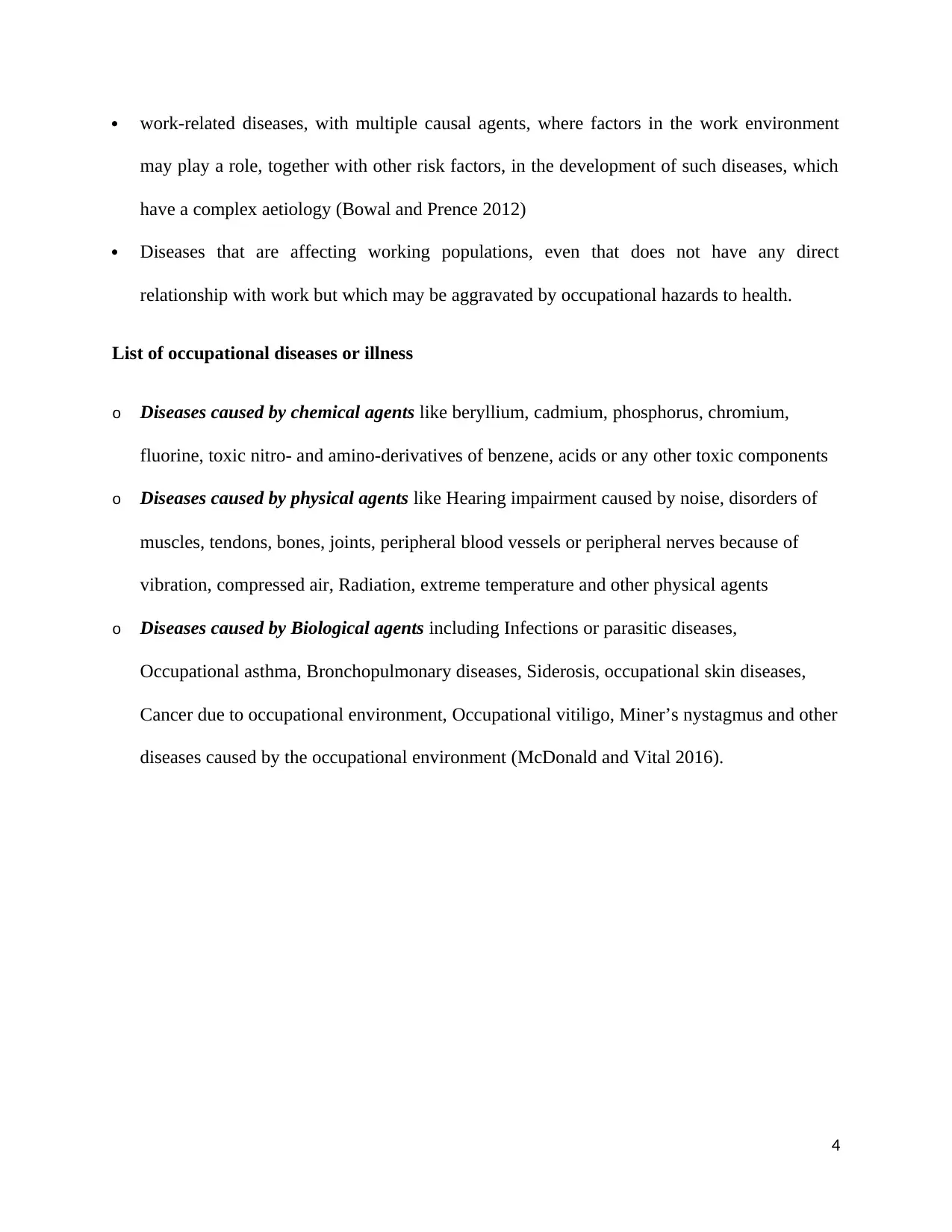
work-related diseases, with multiple causal agents, where factors in the work environment
may play a role, together with other risk factors, in the development of such diseases, which
have a complex aetiology (Bowal and Prence 2012)
Diseases that are affecting working populations, even that does not have any direct
relationship with work but which may be aggravated by occupational hazards to health.
List of occupational diseases or illness
o Diseases caused by chemical agents like beryllium, cadmium, phosphorus, chromium,
fluorine, toxic nitro- and amino-derivatives of benzene, acids or any other toxic components
o Diseases caused by physical agents like Hearing impairment caused by noise, disorders of
muscles, tendons, bones, joints, peripheral blood vessels or peripheral nerves because of
vibration, compressed air, Radiation, extreme temperature and other physical agents
o Diseases caused by Biological agents including Infections or parasitic diseases,
Occupational asthma, Bronchopulmonary diseases, Siderosis, occupational skin diseases,
Cancer due to occupational environment, Occupational vitiligo, Miner’s nystagmus and other
diseases caused by the occupational environment (McDonald and Vital 2016).
4
may play a role, together with other risk factors, in the development of such diseases, which
have a complex aetiology (Bowal and Prence 2012)
Diseases that are affecting working populations, even that does not have any direct
relationship with work but which may be aggravated by occupational hazards to health.
List of occupational diseases or illness
o Diseases caused by chemical agents like beryllium, cadmium, phosphorus, chromium,
fluorine, toxic nitro- and amino-derivatives of benzene, acids or any other toxic components
o Diseases caused by physical agents like Hearing impairment caused by noise, disorders of
muscles, tendons, bones, joints, peripheral blood vessels or peripheral nerves because of
vibration, compressed air, Radiation, extreme temperature and other physical agents
o Diseases caused by Biological agents including Infections or parasitic diseases,
Occupational asthma, Bronchopulmonary diseases, Siderosis, occupational skin diseases,
Cancer due to occupational environment, Occupational vitiligo, Miner’s nystagmus and other
diseases caused by the occupational environment (McDonald and Vital 2016).
4
Paraphrase This Document
Need a fresh take? Get an instant paraphrase of this document with our AI Paraphraser
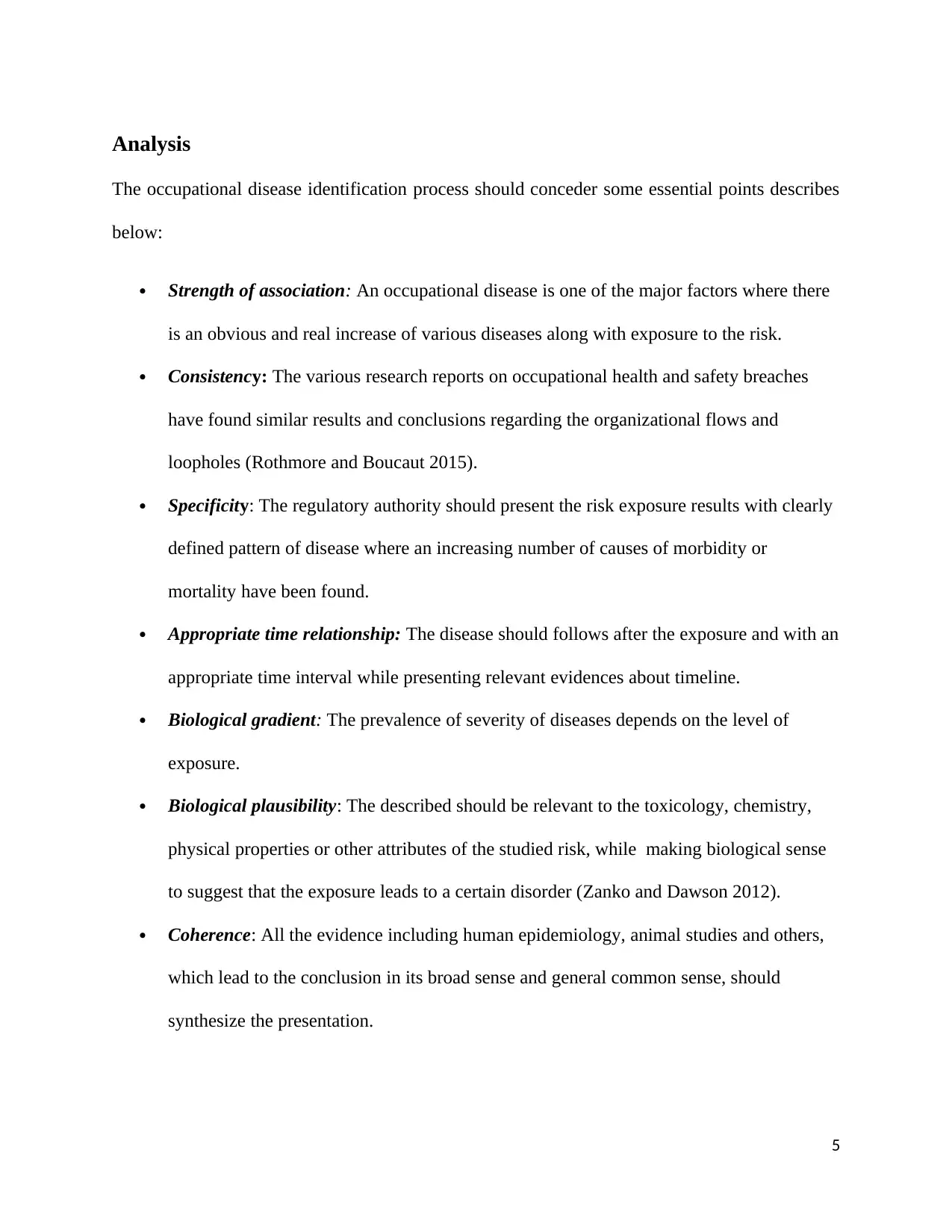
Analysis
The occupational disease identification process should conceder some essential points describes
below:
Strength of association: An occupational disease is one of the major factors where there
is an obvious and real increase of various diseases along with exposure to the risk.
Consistency: The various research reports on occupational health and safety breaches
have found similar results and conclusions regarding the organizational flows and
loopholes (Rothmore and Boucaut 2015).
Specificity: The regulatory authority should present the risk exposure results with clearly
defined pattern of disease where an increasing number of causes of morbidity or
mortality have been found.
Appropriate time relationship: The disease should follows after the exposure and with an
appropriate time interval while presenting relevant evidences about timeline.
Biological gradient: The prevalence of severity of diseases depends on the level of
exposure.
Biological plausibility: The described should be relevant to the toxicology, chemistry,
physical properties or other attributes of the studied risk, while making biological sense
to suggest that the exposure leads to a certain disorder (Zanko and Dawson 2012).
Coherence: All the evidence including human epidemiology, animal studies and others,
which lead to the conclusion in its broad sense and general common sense, should
synthesize the presentation.
5
The occupational disease identification process should conceder some essential points describes
below:
Strength of association: An occupational disease is one of the major factors where there
is an obvious and real increase of various diseases along with exposure to the risk.
Consistency: The various research reports on occupational health and safety breaches
have found similar results and conclusions regarding the organizational flows and
loopholes (Rothmore and Boucaut 2015).
Specificity: The regulatory authority should present the risk exposure results with clearly
defined pattern of disease where an increasing number of causes of morbidity or
mortality have been found.
Appropriate time relationship: The disease should follows after the exposure and with an
appropriate time interval while presenting relevant evidences about timeline.
Biological gradient: The prevalence of severity of diseases depends on the level of
exposure.
Biological plausibility: The described should be relevant to the toxicology, chemistry,
physical properties or other attributes of the studied risk, while making biological sense
to suggest that the exposure leads to a certain disorder (Zanko and Dawson 2012).
Coherence: All the evidence including human epidemiology, animal studies and others,
which lead to the conclusion in its broad sense and general common sense, should
synthesize the presentation.
5
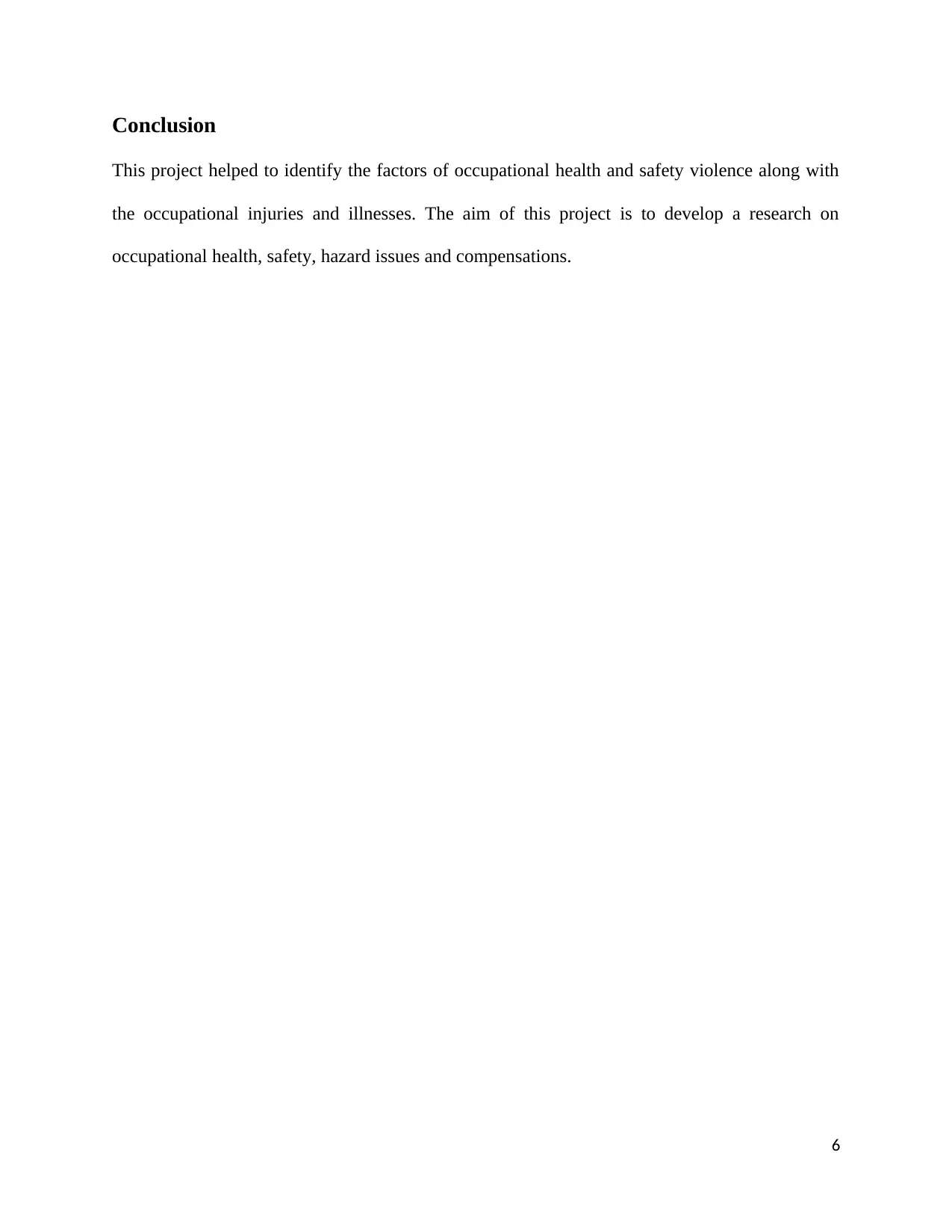
Conclusion
This project helped to identify the factors of occupational health and safety violence along with
the occupational injuries and illnesses. The aim of this project is to develop a research on
occupational health, safety, hazard issues and compensations.
6
This project helped to identify the factors of occupational health and safety violence along with
the occupational injuries and illnesses. The aim of this project is to develop a research on
occupational health, safety, hazard issues and compensations.
6
⊘ This is a preview!⊘
Do you want full access?
Subscribe today to unlock all pages.

Trusted by 1+ million students worldwide
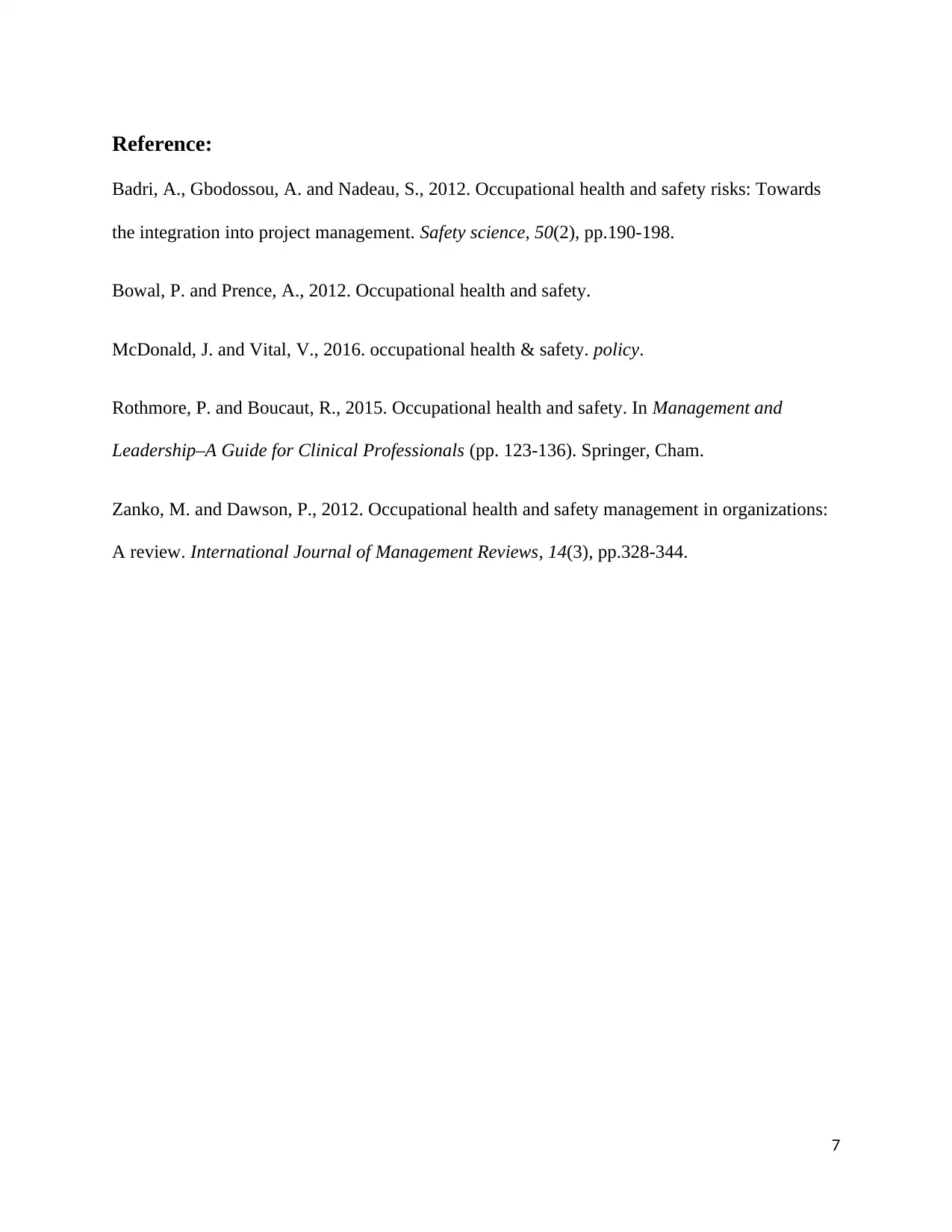
Reference:
Badri, A., Gbodossou, A. and Nadeau, S., 2012. Occupational health and safety risks: Towards
the integration into project management. Safety science, 50(2), pp.190-198.
Bowal, P. and Prence, A., 2012. Occupational health and safety.
McDonald, J. and Vital, V., 2016. occupational health & safety. policy.
Rothmore, P. and Boucaut, R., 2015. Occupational health and safety. In Management and
Leadership–A Guide for Clinical Professionals (pp. 123-136). Springer, Cham.
Zanko, M. and Dawson, P., 2012. Occupational health and safety management in organizations:
A review. International Journal of Management Reviews, 14(3), pp.328-344.
7
Badri, A., Gbodossou, A. and Nadeau, S., 2012. Occupational health and safety risks: Towards
the integration into project management. Safety science, 50(2), pp.190-198.
Bowal, P. and Prence, A., 2012. Occupational health and safety.
McDonald, J. and Vital, V., 2016. occupational health & safety. policy.
Rothmore, P. and Boucaut, R., 2015. Occupational health and safety. In Management and
Leadership–A Guide for Clinical Professionals (pp. 123-136). Springer, Cham.
Zanko, M. and Dawson, P., 2012. Occupational health and safety management in organizations:
A review. International Journal of Management Reviews, 14(3), pp.328-344.
7
Paraphrase This Document
Need a fresh take? Get an instant paraphrase of this document with our AI Paraphraser

Lab Task sheet
8
8
1 out of 8
Related Documents
Your All-in-One AI-Powered Toolkit for Academic Success.
+13062052269
info@desklib.com
Available 24*7 on WhatsApp / Email
![[object Object]](/_next/static/media/star-bottom.7253800d.svg)
Unlock your academic potential
Copyright © 2020–2025 A2Z Services. All Rights Reserved. Developed and managed by ZUCOL.





